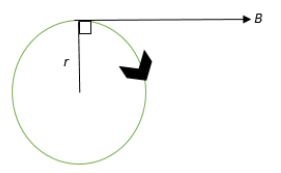
An electron performs circular motion of radius r, perpendicular to a uniform magnetic field B. The kinetic energy gained by this electron in one revolution is_____
A. \[\dfrac{1}{2}M{{V}^{2}}\]
B. zero
C. \[\dfrac{1}{4}M{{V}^{2}}\]
D. \[\pi rBeV\]
Answer
552.9k+ views
Hint:When an electron or any charged particle performs circular motion, then magnetic force acts perpendicular to the particle and the kinetic energy of the electron will not change. The magnetic force acting on the body will be equal to the centrifugal force as the body moves in a circular motion.
Complete answer:
A diagram can be illustrated as follows:

The electron performs circular motion of radius r. Also it is perpendicular to a uniform magnetic Field ‘B’.
Since, the electron moves in a direction perpendicular to the magnetic field, there is no work done, so the kinetic energy and speed of a charged particle in a uniform magnetic field remains constant.
The Centripetal force to the electron is provided by magnetic Lorentzian force so that
\[\Rightarrow qvB=\dfrac{M{{V}^{2}}}{r}\]
In general \[{{F}_{c}}=\dfrac{M{{V}^{2}}}{r}\]
So we can write ${{F}_{c}}=qvB$
The electron moves in circular motion which is perpendicular to the magnetic field. So, the kinetic energy will be zero.
\[r=\dfrac{M{{V}^{2}}}{qVB}\]
Here, r called the cyclotron radius.
Hence, the correct choice is option (B) zero.
Note:
As we know at the time of circular motion when the velocity of an electron is perpendicular to the magnetic field, the speed and kinetic energy of the particle does not change, in other words, remains constant. Also radius of circular path followed by electron is proportional to speed of electron.
Complete answer:
A diagram can be illustrated as follows:

The electron performs circular motion of radius r. Also it is perpendicular to a uniform magnetic Field ‘B’.
Since, the electron moves in a direction perpendicular to the magnetic field, there is no work done, so the kinetic energy and speed of a charged particle in a uniform magnetic field remains constant.
The Centripetal force to the electron is provided by magnetic Lorentzian force so that
\[\Rightarrow qvB=\dfrac{M{{V}^{2}}}{r}\]
In general \[{{F}_{c}}=\dfrac{M{{V}^{2}}}{r}\]
So we can write ${{F}_{c}}=qvB$
The electron moves in circular motion which is perpendicular to the magnetic field. So, the kinetic energy will be zero.
\[r=\dfrac{M{{V}^{2}}}{qVB}\]
Here, r called the cyclotron radius.
Hence, the correct choice is option (B) zero.
Note:
As we know at the time of circular motion when the velocity of an electron is perpendicular to the magnetic field, the speed and kinetic energy of the particle does not change, in other words, remains constant. Also radius of circular path followed by electron is proportional to speed of electron.
Recently Updated Pages
Why is there a time difference of about 5 hours between class 10 social science CBSE

In cricket, what is a "pink ball" primarily used for?

In cricket, what is the "new ball" phase?

In cricket, what is a "death over"?

What is the "Powerplay" in T20 cricket?

In cricket, what is a "super over"?

Trending doubts
What is meant by exothermic and endothermic reactions class 11 chemistry CBSE

Which animal has three hearts class 11 biology CBSE

10 examples of friction in our daily life

One Metric ton is equal to kg A 10000 B 1000 C 100 class 11 physics CBSE

1 Quintal is equal to a 110 kg b 10 kg c 100kg d 1000 class 11 physics CBSE

Difference Between Prokaryotic Cells and Eukaryotic Cells




